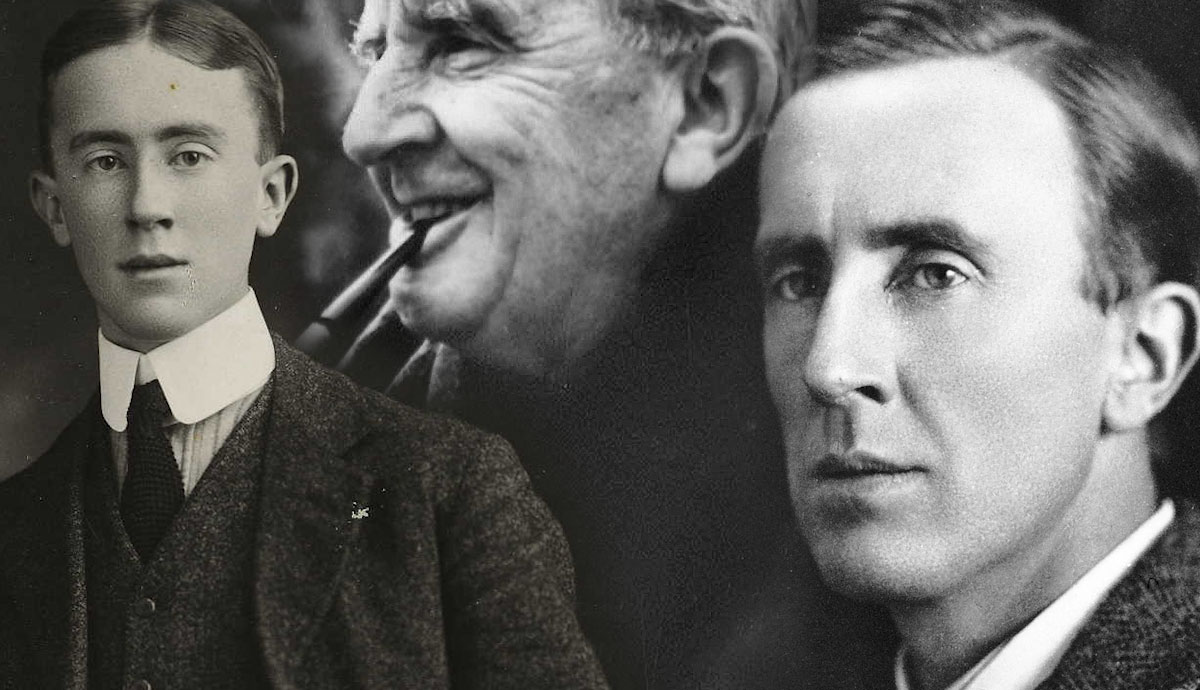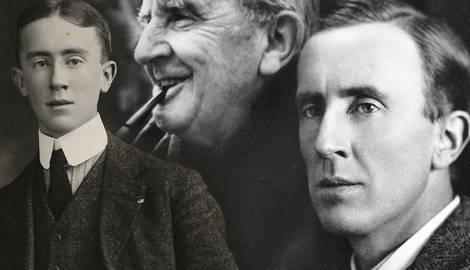
J.R.R. Tolkien is perhaps most famous for writing The Hobbit and his The Lord of the Rings trilogy. In doing so, he conceived a fantastical world of unparalleled detail and complexity that continues to appeal to legions of readers today. But this was just one of his many roles during his long and fascinating life. As well as being a philologist and scholar, Tolkien was also a soldier during the First World War, a devout Catholic, a loving husband and father to four children, and a loyal friend.
J.R.R. Tolkien’s Early Years

John Ronald Reuel Tolkien was born on the 3rd of January 1892 in Bloemfontein in what was then known as the Orange Free State in South Africa. Tolkien spent his infancy in South Africa until, at age three, he, his mother, and his younger brother, Hilary, went to England to visit their family. Though the plan had been for his father to join the three of them at a later date, he died of rheumatic fever in Bloemfontein, leaving his family without an income.
They therefore settled in England, moving in with Tolkien’s maternal grandparents in Kings Heath, Birmingham. Birmingham – and the English Midlands more generally – would go on to have a pronounced effect on his fiction. His aunt, for example, had a farm called Bag End, a name that would reappear later in Tolkien’s writing.
However, Tolkien’s family did not stay too long in his maternal grandparents’ home. In 1900, his mother converted to Catholicism, and her parents, being devout Baptists, severed ties with her and her children. He attended King Edward’s School in Birmingham before moving to St Philip’s School, a Roman Catholic establishment, before resuming his studies at King Edward’s on a Foundation Scholarship in 1903. A year later, however, his mother died from diabetic ketoacidosis, aged just 34, leaving her two sons in the guardianship of Father Francis Xavier Morgan in order to ensure that they would be brought up according to the Catholic faith after her death.

Another aspect of Tolkien’s childhood that informed his later interests, and, in turn, his writing, was his introduction to constructed languages, courtesy of his cousins Mary and Marjorie Incledon, who invented their own language called Animalis. Tolkien also invented his own language (Newbosh) and learned Esperanto. A committed linguist, he specialized in English philology at university, taking Old Norse as his special subject. He also worked for the Oxford English Dictionary for a period, primarily researching the history and etymology of words of Germanic origin. It was his philological training, as well as his childhood enthusiasm for constructed languages, that would inspire Tolkien to invent languages for his later works of fantastical fiction.
On a more personal note, a meeting between Tolkien, aged 16, and Edith Mary Bratt, his future wife, also had a significant impact on his life. At the time, however, Tolkien’s legal guardian Father Morgan disapproved of the match: both Tolkien and Edith were very young, although Edith was the elder of the two by three years, and Edith was a Protestant. He therefore prohibited Tolkien from contacting and communicating with Edith until his twenty-first birthday, on which date Tolkien duly wrote to her, asking her to marry him.
In her reply, Edith revealed that she, having despaired of the likelihood that she and Tolkien would be able to marry, had become engaged to another man, the brother of a school friend of hers. After spending the day together on January 8th, 1913, however, she broke off this engagement and converted to Catholicism at Tolkien’s request. The couple was married on March 22nd, 1916 at St. Mary Immaculate Catholic Church, Warwick, and would go on to have four children together during their long and happy marriage.
Early Manhood: Student, Soldier, Scholar

Tolkien is perhaps most closely associated with Oxford, where he first went as a student in 1911 to study at Exeter College. He had initially enrolled to study Classics, but in 1913, he switched to English Language and Literature, graduating in 1915 with First Class honors.
While still at university, the First World War began. Rather than signing up as soon as the war had been announced (as was expected of him by many of his relatives), Tolkien instead deferred enlisting until he had completed his degree. Having graduated in 1915, he became a temporary Second Lieutenant in the Lancashire Fusiliers on the 15th of July and trained with the Thirteenth (Reserve) Battalion. During this time, he conceived a strong dislike for those of superior military rank. He felt a greater kinship with the working-class soldiers under his command and was frustrated that military protocol prohibited cross-rank friendships.
His military career also encompassed the Battle of the Somme. While attacking Regina Trench, Tolkien caught trench fever and was invalided to England on November 8th, 1916. Though he was eventually deemed unfit for general service, during his convalescence, he began work on The Book of Lost Tales, starting with The Fall of Gondolin. On July 16th, 1919, he was formally discharged from active service and given a temporary disability pension before officially leaving the army in 1920.
1920 also saw Tolkien secure employment as a reader in English Language at the University of Leeds, where he became the youngest member of the academic staff. Here, he wrote A Middle English Vocabulary and a definitive scholarly edition of Sir Gawain and the Green Knight alongside E.V. Gordon and translated Sir Gawain, Pearl, and Sir Orfeo.
Returning to Oxford

In 1925, Tolkien returned to Oxford as Rawlinson and Bosworth Professor of Anglo-Saxon, with a fellowship at Pembroke College. During his time here, he wrote The Hobbit and the first two volumes of The Lord of the Rings: The Fellowship of the Ring and The Two Towers. A year after arriving at Oxford, he also finished translating the Old English epic poem Beowulf, though it would remain unpublished until 2014, long after his death.
Though he did not live to see his translation of the poem published, his scholarship did help change the intellectual discourse surrounding Beowulf. In 1936, Tolkien delivered his lecture, “Beowulf: The Monsters and the Critics.” Though Tolkien was primarily a philologist rather than a literary scholar and critic, this lecture heralded a new era in the study of the text by foregrounding its poetic potency over its linguistic interests.
In 1945, Tolkien moved to Merton College, taking up his post as Merton Professor of English Language and Literature. It was here that he finished writing The Lord of the Rings trilogy in 1948, and he remained at Merton College until his retirement in 1959.

It was also in Oxford that Tolkien became part of the Inklings, an informal group of literary enthusiasts that included C.S. Lewis, Lord David Cecil, and Hugo Dyson, who would all gather to discuss literature from the early 1930s to 1949. The primary function of the Inklings was to allow its members to read aloud from their own works in progress and so obtain feedback from their peers. Tolkien read early drafts of The Lord of the Rings over these meetings (much to the distaste of literary scholar Hugo Dyson), held either in Lewis’ rooms in Magdalene College every Thursday or in the rather more informal setting of the local pub, The Eagle and Child (known locally as The Bird and Baby) at midday on Tuesdays during term time.
Later Years & J.R.R. Tolkien’s Legacy

When Tolkien retired, aged 73, from his academic position at Oxford University in 1959, he was a rich and famous writer. His works of fantastical fiction had won him international acclaim, and he and Edith moved to Bournemouth to escape the attention of some of his more ardent fans. While Edith enjoyed their new wealth and the status it brought her in Bournemouth (which, at the time, was frequented by the upper echelons of British society), Tolkien missed Oxford society and the Inklings most especially. When C.S. Lewis died in 1963, Tolkien wrote to his daughter: “So far I have felt like an old tree that is losing all its leaves one by one: this feels like an axe-blow near the roots.” However, Tolkien managed to keep himself busy with academic and intellectual projects, working as a consultant and translator for The Jerusalem Bible.
If Tolkien experienced Lewis’ death as “an axe-blow near the roots,” his life was even more upset by Edith’s death in 1971 at the age of 82. After her death, Tolkien returned once more to Oxford, where he was granted rooms in Merton College.
A year after Edith’s death, he was made a Commander of the Order of the British Empire as part of 1972’s New Year Honors and was granted the insignia of the Order in a ceremony at Buckingham Palace on the 28th of March. In the same year, he also received an honorary Doctorate of Letters from his old alma mater and employer, Oxford University.

J.R.R. Tolkien passed away on September 2nd, 1973 from a bleeding ulcer and a chest infection. He was 81 years old. He was buried alongside Edith at Wolvercote Cemetery in Oxford. Alongside their names, their graves are marked “Lúthien” and “Beren” – a reference to two characters from Tolkien’s Middle Earth. Lúthien is an immortal elf maiden, while Beren is a mortal man. Their undying love for each other leads them to undertake epic quests and to Lúthien making the ultimate sacrifice in renouncing her immortality so that she will not have to live without the man she loves. His own love for his wife had inspired him to create this story, and by thus marking their graves, Tolkien made a final gesture of love to his wife, even after death.
J.R.R. Tolkien lived a long and fascinating life – not least because he lived through extraordinary times, serving as a Second Lieutenant in the British army during the First World War. It is for his work as a writer after the war, once he had returned to civilian life, however, for which he is most famous today. His fantastical fiction continues to be read and loved by millions of fans around the world. He also made important contributions to the world of academia in his capacity as a philologist and (sometime) literary critic at Oxford University.
Aside from his professional life, however, Tolkien was a man of deep faith, a loyal friend, a devoted husband, and a doting father, who wrote his children letters from Father Christmas and concocted tales of Middle Earth that would give rise to The Hobbit and The Lord of the Rings. Just as he was able to create a fictional world of unsurpassable detail and complexity, Tolkien himself lived a rich and full life.










